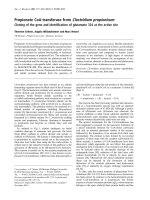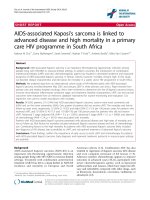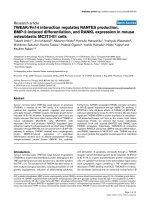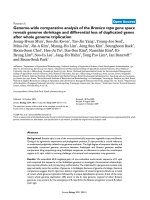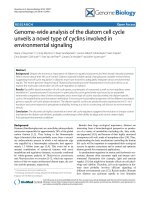Báo cáo y học: "Eyes wide shut - unusual two stage repair of pectus excavatum and annuloaortic ectasia in a 37 year old marfan patient: case report." pdf
Bạn đang xem bản rút gọn của tài liệu. Xem và tải ngay bản đầy đủ của tài liệu tại đây (1.65 MB, 3 trang )
CAS E REP O R T Open Access
Eyes wide shut - unusual two stage repair of
pectus excavatum and annuloaortic ectasia in a
37 year old marfan patient: case report
Martin TR Grapow
*
, Paula Campelos, Clemente Barriuso and Jaume Mulet
Abstract
We report about a 37 year old male patient with a pectus excavatum. The patient was in NYHA functional class III.
After performed computed tomography the symptoms were thought to be related to the severity of chest
deformation. A Ravitch-procedure had been accomplished in a district hospital in 2009. The crack of a metal bar
led to a reevaluation 2010, in which surprisingly the presence of an annuloaortic ectasia (root 73 × 74 mm) in
direct neighborhood of the formerly implanted metal-bars was diagnosed. Echocardiography revealed a severe
aortic valve regurgitation, the left ventricle was massively dilated presenting a reduced ejection fraction of 45%. A
marfan syndrome was suspected and the patient underwent a valve sparing aortic root replacement (David
procedure) in our institution with an uneventful postoperative course. A review of the literature in combination
with discussion of our case suggests the application of stronger recommendations towards preoperative
cardiovascular assessment in patients with pectus excavatum.
Background
There are no guidelines concerning the clinical evalua-
tion of patients with isolated pectus excavatum prior
surgical repair, but some recommendations do exist
[1,2]. Besides radiographic evaluation using a computer-
ized tomographic scan (CT), performance of an ECG,
transthoracic or transesophageal echocardiogram, pul-
monary function testing and cardio-pulmonary exercise
testing are suggested. However, the extent of physic al
und especially image-guided examinations is generally
on discretion of the physician in charge. In our patient
important signs have been ignored retrospectively,
which finally led to an unusual two-stage repair.
Case presentation
A 37 year old man was referred to a district hospital
with pectus excavatum and progressive shortness of
breath. Native computed tomography revealed an exces-
sively deformed chest (Figure 1) and symptoms were
thought to be related to the anatomical situation. After
presentation of the patient in the thoracic surgery unit,
he was scheduled for an operative correction. A
Ravitch-procedure had been performed in July 2009.
The patient’s pectus excavatum was addressed using two
metal bars. They were placed in a parallel fashion with
the ends supported by the lateral thorax at the level of
the third and fourth rib and fixed with ripclamps. The
middle portion of the chest was straightened by the bar
running under neath it. The patient showed an unevent-
ful post-op course and was discharged on day 9
postoperatively.
Although the anatomical shape was almost normalized
after the operative intervention, fatigue, shortness of
breath and palpitation were still persistent. A broken
and dislocated lower metal bar with concomitant
instability (Figure 2) led to a reevaluation in May 2010.
After realization of a follow up computed tomography
surprisingly and as a co-finding, a severely dilated
ascending aorta >7 cm was found, located in direct
neighborhood to the metal bars (Figure 3). The follow-
ing cardiological investigations (echocardiography, MRI)
revealed a tricuspid aortic valve with a severe aortic
regurgitation due to an annuloaortic ectasia (73 × 74
mm root), a massively dilated left ventricle (LVEDD 85
mm) without hypertrophy and a slightly reduced ejec-
tion fraction of 45%. The mitral valve showed a normal
* Correspondence:
Department of Cardiovascular Surgery, Hospital Clínic, University of
Barcelona, Barcelona, Spain
Grapow et al. Journal of Cardiothoracic Surgery 2011, 6:64
/>© 2011 Grapow et al; licensee BioMed Central Ltd. This is an Open Access art icle distributed under the terms of the Creative Commons
Attribution License (http://creativecommons.o rg/licenses/by/2.0), which permits unrestricted use, distribution, and reproduction in
any medium, provided the original work is properly cited.
morphology with mild regurgitation but with normal
annular, valvular and subvalvular conditions.
The patient was transferred to the Hospital Clinic for
surgical correction of t he cardiovascular pathology.
After midline sternotomy the two titan bars were identi-
fied. The lower dislocated and broken bar was removed
completely, the upper bar was cut and 3 cm were
removed. The pericardium was totally intact after the
Ravich-procedure. After openi ng of the pericar dium the
huge annuloaortic aneurysm became visible. After
heparinization and installation of the extracorporal cir-
culation with aortic cannulation of the arch and venous
cannulation using a two-stage cannula placed into the
right atrium cardiopulmonary bypass was started. The
ascending aort a was distally crossclamped directly
underneath the brachiocephalic trunc. After inspection
of the aortic valve and almost complete resection of the
ascending aorta, a valve sparing aortic root replacement
(David procedure) using a straight 30 mm Hemashield
prosthesis with lateral insertion of the coronary ostia
was performed. The echocardiography showed a perfect
valve function with low gradients. After weaning from
bypass and decannulation protamin was substituted.
The sternum was closed using the Robiscek wire rein-
forcement technique. Apart from a short period of atrial
flutter and a spontaneously resolved paralytic ileus the
patient’ s postoperative course was uneventful and he
was discharged at day 10 postoperatively.
Discussion
Historically, when underlying anatomical structures were
not considerably affected by the pectus excavatum, a
two-stage repair with a first intervention focused on the
cardiovasc ular pathology followed by a second operation
addressing the thoracic wall was recommended [3].
Simultaneous repair of both lesions was discouraged
because of concerns regarding the potential for major
complications, such as limited exposure of the heart,
excessive bleeding, and increased risk of wound infec-
tion. In the la st decade reports about successful simulta-
neously performed single -stage repairs became evident
[4-6].
We now report about an unusual two-stage repair of a
pectus excavatum and an annuloaortic ectasia in a 37
Figure 1 Initial CT-scan showing the pectus excavatum.
Figure 2 X-ray at r eadmission. Red Arrows indicating the crack
and dislocation of the metal bars.
Figure 3 Follow-up CT-scan. Red arrow demonstrates t he close
relationship between one of the metal bars and the annuloaortic
ectasia.
Grapow et al. Journal of Cardiothoracic Surgery 2011, 6:64
/>Page 2 of 3
year old marfan patient. Due to a missed f inding of an
enlarged aorta in the initial computed tomography with-
out contrast medium and the lack of essent ial diagnos-
tics preoperatively our patient was first operated on the
chest deformity using the Ravitch-Procedure. As seen in
Figure 3 the bars dangerously almost touch the dilated
aorta, which in fact is only covered by the pericardium.
Fortunately the early crack in one metal bar combined
with partial instability (Figure 2) led to a follow-up
examination before a potentially hazardous alteration of
the aortic situation may have occurred. The f ollowing
diagnosis of the annuloaortic dilation points out the
importance of a thoroughly raised history and physical
examination. Retrospectively, three Marfan criteria could
have been detected preoperatively by physical examina-
tion in our patient apart from the annuloaortic ectasia,
i.e. pectus excavatum, arm span to height ratio >1.05
and facial appearances with dolichocephaly and enoph-
talmos. Careful assessment of the initial native com-
puted tomography of the chest furthermore could have
raised suspicion in an aortic enlargement (Figure 4), but
this remains to be difficult to postulate without having
the perfect section and additionally lack of contrast
medium. Although the association of pectus excavatum
with aortic root dilatation is not sufficient to fulfill the
Gent criteria for the diagnosis of Marfan syndrome [7],
aconnectivetissuedisorder seemed not to be exclud-
able even without the knowledge of the aortic pathology.
Rhee and colleagues [8] report about children with
isolated pectus excavatum without a suspected connec-
tive tissue disorder, who were referred for routine echo-
cardiographic evaluation. Importantly they found a
significantly higher prevale nce of a ortic root dilatation
in those children compared to an age-matched control
population.
Conclusion
In our opinion a careful cardiological assessment in
patients with pectus excavatum should be obligatory.
Driven by our experience and literature besides CT we
strongly recommend to perform screening echocardio-
graphy , a non-invasive, safe and inexpensive method, in
all patients even with isolated pectus excavatum in
order to identify those patients with concomi tant cardi-
ovascular manifestations.
Consent
Written informed consent was obtained from the patient
for publication of this case report and any accompany-
ing image. A copy of the written consent is available for
review by the Editor-in-Chief of this journal.
Authors’ contributions
All authors contributed in case management, manuscript preparation and
image acquisition. All authors read and approved the final manuscript.
Competing interests
The authors declare that they have no competing interests.
Received: 17 November 2010 Accepted: 2 May 2011
Published: 2 May 2011
References
1. Jaroszewski D, Notrica D, McMahon L, Steidley DE, Deschamps C: Current
management of pectus excavatum: a review and update of therapy and
treatment recommendations. J Am Board Fam Med 2010, 23:230-239.
2. Kelly RE Jr: Pectus excavatum: historical background, clinical picture,
preoperative evaluation and criteria for operation. Semin Pediatr Surg
2008, 17:181-193.
3. Shamberger RC, Welch KJ, Castaneda AR, Keane JF, Fyler DC: Anterior chest
wall deformities and congenital heart disease. J Thorac Cardiovasc Surg
1988, 96:427-432.
4. Willekes CL, Backer CL, Mavroudis C: A 26-year review of pectus deformity
repairs, including simultaneous intracardiac repair. Ann Thorac Surg 1999,
67:511-518.
5. Ryu YG, Baek MJ, Kim HK, Choi YH, Sohn YS, Kim HJ: Simultaneous repair
for aortic incompetence with annuloaortic ectasia and pectus
excavatum by modified Ravitch procedure with pectus bars in an adult
patient with Marfan syndrome. J Thorac Cardiovasc Surg 2009, 137:e34-36.
6. Haller C, Sarai K, Siepe M, Beyersdorf F: Concomitant mitral valve
replacement and re-re-repair of severe pectus deformity correction in a
patient with Marfan syndrome. J Thorac Cardiovasc Surg 2010, 140:e75-76.
7. DePaepe A, Devereux RB, Dietz HC, Hennekam RC, Pyeritz RE: Revised
diagnostic criteria for the Marfan syndrome. Am J Med Genet 1996,
62:417-426.
8. Rhee D, Solowiejczyk D, Altmann K, Prakash A, Gersony WM, Stolar C,
Kleinman C, Anyane-Yeboa K, Chung WK, Hsu D: Incidence of aortic root
dilatation in pectus excavatum and its association with Marfan
syndrome. Arch Pediatr Adolesc Med 2008, 162:882-885.
doi:10.1186/1749-8090-6-64
Cite this article as: Grapow et al.: Eyes wide shut - unusual two stage
repair of pectus excavatum and annuloaortic ectasia in a 37 year old
marfan patient: case report. Journal of Cardiothoracic Surgery 2011 6:64.
Figure 4 Initial CT-scan showing the ascending (red arrow) and
descending aorta (green arrow). The ascending aorta appears to
be significantly more dilated as it should be.
Grapow et al. Journal of Cardiothoracic Surgery 2011, 6:64
/>Page 3 of 3
